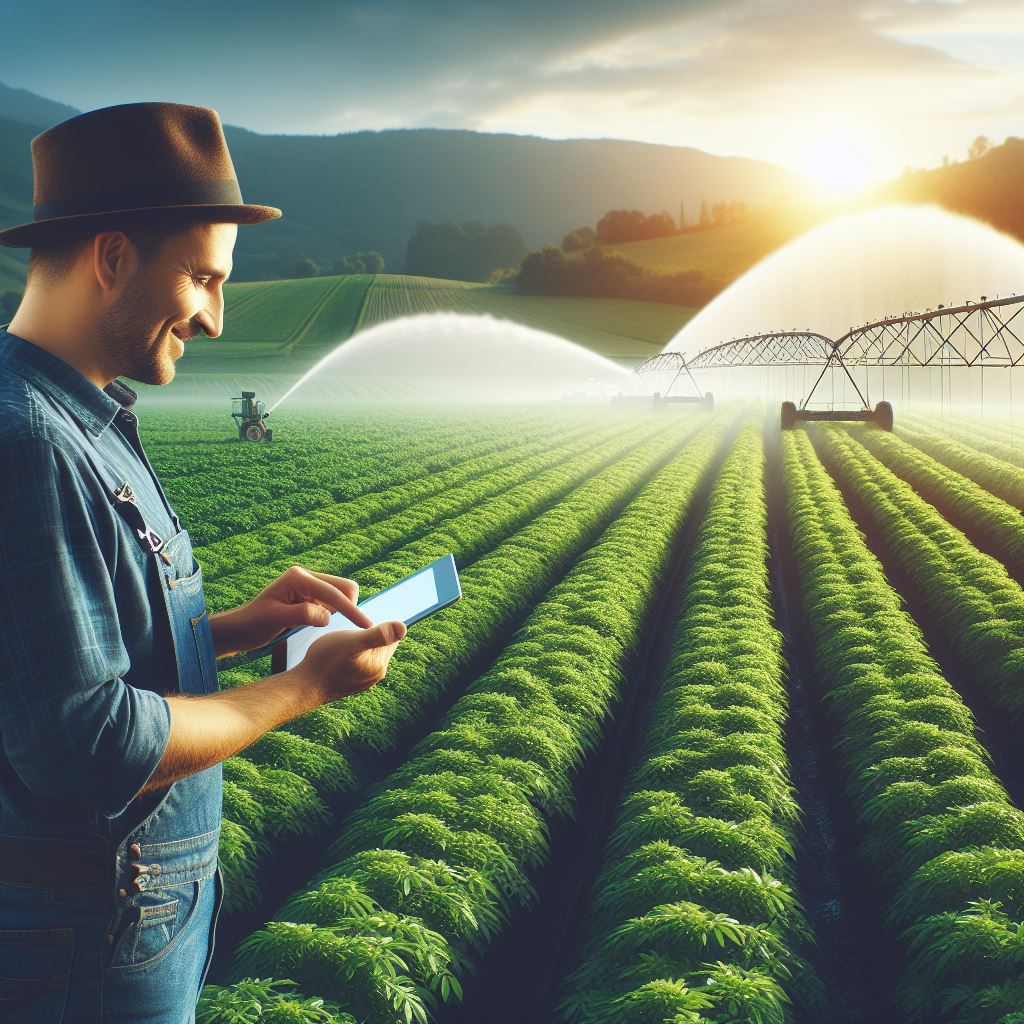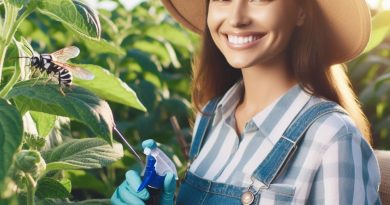Irrigation Scheduling for Optimal Crop Growth
Last Updated on March 2, 2024
Introduction
Irrigation scheduling plays a vital role in ensuring optimal crop growth and maximizing yields.
It determines when and how much water should be applied to the crops, considering their specific water requirements.
Explanation of the importance of irrigation scheduling for crop growth
Proper irrigation scheduling is crucial for crop growth as it helps maintain soil moisture at the optimal level.
This ensures that plants have access to adequate water for their growth and development. Insufficient irrigation may lead to water stress, affecting plant health and reducing yields.
Conversely, over-irrigation can lead to waterlogging, which hampers root development and can cause diseases.
Irrigation scheduling also helps manage water resources efficiently, given increasing water scarcity.
By optimizing water application and minimizing waste, it reduces the pressure on limited water supplies and promotes sustainable farming practices.
Brief overview of the purpose of the blog post
This blog post aims to provide insights into irrigation scheduling for farmers and agricultural enthusiasts.
It will discuss the various scheduling methods available, the factors to consider when scheduling irrigation, and the benefits of using advanced technologies for precise irrigation management.
Additionally, it will highlight the impact of irrigation scheduling on crop yield, quality, and overall farm profitability.
By understanding the importance of irrigation scheduling and adopting appropriate practices, farmers can enhance their crop production, reduce water consumption, and contribute to the long-term sustainability of agriculture.
Understanding Crop Water Requirements
To achieve optimal crop growth, it is crucial to understand the water needs of different crops. Several factors influence crop water requirements, including crop type, growth stage, and climate conditions.
Matching irrigation to crop water needs is significant in ensuring successful crop development.
Factors Affecting Crop Water Requirements
- Crop Type: Different crops have varying water requirements. For example, leafy greens like lettuce need more water compared to drought-tolerant crops like cacti.
- Growth Stage: Crop water requirements change throughout the growth cycle. Young plants require more water to establish their root systems, while mature plants need less water.
- Climate Conditions: Temperature, humidity, wind, and solar radiation impact crop water needs. Hot and dry climates increase evapotranspiration, requiring more irrigation.
Significance of Matching Irrigation to Crop Water Needs
- Water Conservation: Applying the right amount of water based on crop water requirements helps conserve this precious resource. Wasteful irrigation practices contribute to water scarcity and environmental degradation.
- Enhanced Crop Health: Overwatering or underwatering can harm crop health. Adequate irrigation ensures plants receive sufficient water, optimizing their growth and reducing the risk of plant diseases.
- Increased Crop Yield: Providing crops with the right amount of water maximizes their potential yield. Proper irrigation management facilitates nutrient uptake and supports physiological processes crucial for crop productivity.
- Cost Efficiency: By tailoring irrigation to crop water needs, farmers can avoid unnecessary water expenses. Over-irrigation not only wastes water but also incurs additional costs for pumping and energy consumption.
- Nutrient Management: The right amount of water aids in the proper distribution of nutrients in the soil. This allows plants to absorb essential elements, resulting in healthier crops and minimizing nutrient runoff.
- Reduced Soil Erosion: Adequate irrigation prevents soil from becoming too dry or saturated. Maintaining proper moisture levels helps prevent erosion and soil degradation, preserving soil fertility over time.
- Environmental Sustainability: Efficient irrigation practices reduce the negative impact on the environment. Conserving water resources and minimizing runoff or leaching of chemicals contribute to a sustainable approach to agriculture.
Implementing Effective Irrigation Strategies
- Monitoring Tools: Utilize soil moisture sensors and weather stations to monitor crop water needs accurately. These tools provide real-time data, allowing farmers to adjust irrigation schedules accordingly.
- Irrigation Methods: Choose appropriate irrigation methods such as drip irrigation or sprinkler systems based on crop type, field size, and water availability. This ensures efficient water distribution and minimizes losses.
- Irrigation Scheduling: Develop a schedule that aligns with crop growth stages and climatic conditions. This involves determining the frequency and duration of irrigation events to meet crop water demands.
- Water Source Management: Optimize water sources by using rainwater harvesting, recycled water, or efficient water storage systems. Exploring alternative water sources reduces reliance on freshwater supplies.
- Education and Training: Promote knowledge sharing among farmers regarding irrigation best practices. Training programs and workshops can enhance their understanding of crop water requirements and irrigation techniques.
In genral, understanding crop water requirements is vital for optimizing crop growth. Factors such as crop type, growth stage, and climate conditions influence these needs.
By matching irrigation to crop water needs, farmers can conserve water, improve crop health, increase yields, and minimize environmental impact.
Implementing effective irrigation strategies, such as using monitoring tools, appropriate methods, and proper scheduling, ensures the efficient use of water resources in agriculture.
Types of Irrigation Methods
When it comes to irrigation scheduling for optimal crop growth, choosing the right method is crucial. There are several types of irrigation methods, each with its own pros and cons.
Understanding these methods and their implications can help farmers make informed decisions about which method to use based on their crop requirements and resource availability.
Surface Irrigation
- One common irrigation method is surface irrigation.
- This method involves flooding the entire field with water.
- It is a simple and cost-effective method.
- However, it can lead to water loss due to evaporation and runoff.
- Surface irrigation is ideal for flat fields and crops that can tolerate wet conditions.
Sprinkler Irrigation
- Another popular method is sprinkler irrigation.
- This method simulates rainfall by spraying water over the crops.
- It provides uniform water distribution, reducing water loss.
- Sprinkler irrigation can be expensive due to the cost of equipment and energy.
- It is suitable for a wide range of crops and field topographies.
Drip Irrigation
- Drip irrigation is a highly efficient method.
- Water is applied directly to the roots of the plants through drip emitters.
- This method minimizes water loss through evaporation and runoff.
- Drip irrigation requires careful monitoring and maintenance to prevent clogging.
- It is ideal for water-sensitive crops and areas with limited water resources.
When selecting the most suitable irrigation method, several factors should be taken into consideration. The crop’s water requirements, soil type, and field topography are crucial factors.
Additionally, the availability of water and the farmer’s budget should be considered.
For crops that require constant moisture, such as rice, surface irrigation may be the best option.
However, for crops with shallow roots or those susceptible to diseases caused by wet foliage, like tomatoes, drip irrigation would be a better choice.
In areas with limited water resources, sprinkler irrigation can be a suitable alternative. It reduces water usage while ensuring uniform coverage. However, the initial investment for sprinkler systems can be higher compared to surface irrigation.
It is essential to evaluate the advantages and disadvantages of each method. Farmers must consider the costs, water efficiency, crop yield, and potential environmental impacts.
Ultimately, the goal of irrigation scheduling is to maximize crop yield and minimize water waste. Proper irrigation management can lead to improved crop quality, increased productivity, and reduced water pollution.
In fact, understanding the various irrigation methods and their implications is crucial for optimal crop growth. Surface irrigation, sprinkler irrigation, and drip irrigation each have their own pros and cons.
By considering the crop’s requirements and resource availability, farmers can select the most suitable method for their specific needs. Making informed decisions about irrigation methods is essential for sustainable agriculture and efficient water management.
Factors to Consider in Irrigation Scheduling
When it comes to irrigation scheduling for optimal crop growth, there are several factors that need to be taken into consideration.
These factors play a crucial role in determining the irrigation needs of the crops, and by understanding and monitoring them, farmers can ensure the efficient use of water resources and maximize crop yield.
Detailed Explanation of Factors to Consider
- Soil Moisture Level: The moisture level in the soil is one of the most important factors to consider when scheduling irrigation. It is essential to maintain an optimal moisture level for the crops to ensure their healthy growth and development.
- Weather Forecast: Keeping an eye on the weather forecast is crucial as it helps in determining the watering requirements of the crops. If rain is expected, irrigation scheduling can be adjusted accordingly to avoid overwatering.
- Crop Water Consumption Rate: Understanding the water consumption rate of the crop is essential in determining the frequency and amount of irrigation needed. Different crops have varying water needs, and considering this factor ensures that they receive adequate water for optimal growth.
Importance of Monitoring Soil Moisture and Using Efficient Tools
Monitoring soil moisture and using efficient tools like moisture sensors are crucial in irrigation scheduling. Here’s why:
- Water Efficiency: Monitoring soil moisture allows farmers to avoid overirrigation, reducing water wastage. Using moisture sensors helps in precisely determining the irrigation needs of the crops, leading to optimal water usage.
- Precision Irrigation: By having accurate data on soil moisture, farmers can apply the right amount of water at the right time and in the right place. This precision irrigation technique promotes crop health and minimizes water runoff and leaching.
- Avoiding Water Stress: Monitoring soil moisture levels ensures that crops do not experience water stress, which can have detrimental effects on their growth and yield. By maintaining adequate moisture, farmers can mitigate the risk of crop loss.
- Resource Management: Efficient irrigation scheduling helps in managing water resources effectively. By irrigating based on actual crop needs and real-time data, farmers can prevent water shortages and conserve this valuable resource.
- Cost Savings: Optimizing irrigation scheduling helps in reducing water and energy costs. By avoiding unnecessary irrigation and using water more efficiently, farmers can save money in the long run.
It is evident that factors such as soil moisture level, weather forecast, and crop water consumption rate significantly impact irrigation scheduling.
Proper monitoring of soil moisture and the use of efficient tools like moisture sensors have immense benefits in terms of water conservation, crop health, and cost savings.
By employing these practices, farmers can achieve optimal crop growth while maximizing the efficient use of water resources.
Read: Apple Picking: Timing for Perfect Fruit
Irrigation Scheduling Techniques
In order to achieve optimal crop growth, it is essential to implement effective irrigation scheduling techniques.
This section provides an overview of different scheduling techniques, including time-based scheduling and soil moisture-based scheduling, and explains how to determine the most appropriate technique based on specific crops and environmental conditions.
Time-based Scheduling
- Time-based scheduling involves establishing fixed irrigation intervals to water crops.
- It is a simple and widely used technique, particularly for crops with uniform water requirements.
- However, it may not account for variations in crop water needs based on weather conditions or growth stage.
- Time-based scheduling is suitable for crops that have similar water demand throughout their growth cycle.
Soil Moisture-based Scheduling
- Soil moisture-based scheduling considers the amount of moisture present in the soil before irrigating.
- This technique ensures that crops receive water only when the soil moisture falls below a critical threshold.
- It requires accurate monitoring of soil moisture levels using sensors or manual measurements.
- Soil moisture-based scheduling is particularly beneficial for crops with varying water needs and in areas with unpredictable rainfall.
Determining the Appropriate Scheduling Technique
In order to determine the most suitable scheduling technique, several factors need to be considered:
- Crop Characteristics: Different crops have distinct water requirements at various growth stages.
- Climate: Environmental conditions such as temperature, humidity, and rainfall patterns affect crop water needs.
- Soil Type: Soil composition influences water holding capacity and drainage, impacting irrigation requirements.
- Water Availability: The availability and quality of water resources should be taken into account. Based on these factors, farmers can choose between time-based and soil moisture-based scheduling. For crops with uniform water needs and consistent growth, time-based scheduling may be appropriate. On the other hand, for crops with varying water demands and in areas with limited water availability, soil moisture-based scheduling is more effective.
In all, selecting the appropriate irrigation scheduling technique is crucial for promoting optimal crop growth. While time-based scheduling provides simplicity, soil moisture-based scheduling offers increased precision by considering the moisture content in the soil.
Carefully assessing crop characteristics, climate, soil type, and water availability will help determine the most suitable technique.
Implementing the correct scheduling technique will result in efficient water usage, improved crop yield, and overall sustainability in agriculture.
Read: Soil Health: Boosting Crop Quality & Yield

Advanced Irrigation Tools and Technologies
Introduction to modern irrigation tools, such as weather-based controllers and automated irrigation systems
- Weather-based controllers: These advanced tools utilize real-time weather data to determine irrigation needs.
- Automated irrigation systems: These technologies automatically deliver the required amount of water based on crop demand.
Explanation of how these technologies can enhance irrigation efficiency and crop yield
- Improved water management: Advanced irrigation tools help optimize water distribution, reducing wastage and runoff.
- Real-time data analysis: Weather-based controllers monitor environmental conditions to adjust irrigation schedules accordingly.
- Water conservation: By applying water only when necessary, these technologies promote sustainable water usage.
- Enhanced crop health: Precise irrigation based on weather conditions ensures crops receive the right amount of water.
- Increased crop yield: Advanced irrigation tools optimize the growth environment, leading to higher crop productivity.
- Reduced labor requirements: Automated systems eliminate the need for manual irrigation, saving time and effort.
- Remote control and monitoring: Some advanced tools can be managed remotely, providing convenience and flexibility.
- Precision farming: These technologies enable farmers to fine-tune irrigation, improving overall farm management practices.
Benefits of utilizing advanced irrigation tools and technologies in agriculture.
- Improved resource efficiency: Efficient use of water and energy resources reduces input costs for farmers.
- Climate adaptation: Weather-based controllers adjust irrigation based on changing weather patterns, ensuring crop resilience.
- Reduced environmental impact: Optimal water usage minimizes the risk of water pollution and depletion of water sources.
- Increased profitability: Higher crop yields and cost savings contribute to improved financial returns for farmers.
Challenges and considerations when adopting advanced irrigation tools
- Cost: Initial investment in these technologies can be high, requiring farmers to assess the return on investment.
- Technical knowledge: Farmers may need training and ongoing support to effectively operate and maintain these tools.
- Compatibility: Compatibility with existing irrigation infrastructure needs to be evaluated before implementation.
- Data accuracy and reliability: Regular calibration and maintenance are crucial to ensure accurate data collection and analysis.
Advanced irrigation tools such as weather-based controllers and automated systems offer numerous benefits to farmers.
By improving water management, promoting water conservation, and enhancing crop health, these technologies contribute to increased crop yields and profitability.
However, farmers should carefully consider the cost, technical knowledge, and compatibility aspects before adopting these tools.
Overall, the use of advanced irrigation tools is a promising approach to achieve optimal crop growth while minimizing environmental impact.
Read: Pest Control: Protecting Crops Pre-Harvest
Enhancing Irrigation Efficiency
Irrigation is crucial for optimal crop growth as it provides plants with the necessary water for their development. However, inefficient irrigation practices can lead to water wastage and subpar crop yields.
In this blog section, we will explore ways to enhance irrigation efficiency and maximize crop growth.
Tips for improving irrigation efficiency, such as using proper irrigation system design, maintaining equipment, and reducing water losses
Proper irrigation system design plays a fundamental role in achieving efficient water distribution.
The system should be tailored to the specific crop’s water requirements, soil type, and field topography. It’s essential to assess factors such as the application uniformity and distribution pattern of the irrigation system to identify inefficiencies and make necessary adjustments.
Regular maintenance of irrigation equipment is crucial to achieving optimal performance. Any malfunctioning or damaged parts should be promptly repaired or replaced to prevent water waste.
Checking for leaks, blockages, and ensuring proper calibration of sprinklers and other components are integral to efficient irrigation practices.
Reducing water losses is another critical aspect of improving irrigation efficiency.
Controlling runoff through techniques like contour plowing, terracing, or using berms and swales can minimize water runoff and increase its absorption by the soil. Implementing measures to minimize evaporation, such as applying mulch or using efficient irrigation scheduling, is also vital.
Precision Agriculture and Irrigation
Precision agriculture, with its advanced technology and data-driven approach, plays an essential role in optimizing irrigation practices.
By utilizing tools such as remote sensing, soil moisture sensors, and weather data, farmers can precisely monitor the water needs of their crops.
This information allows for targeted irrigation, reducing water waste while ensuring plants receive the necessary amount of water for growth.
Remote sensing technologies provide valuable insights into crop conditions and allow for a spatial analysis of water requirements.
These tools can detect variations in soil moisture levels, identify areas of water stress, and help farmers make informed decisions on when and where to irrigate.
By precisely targeting irrigation, water usage can be minimized, resulting in more efficient resource utilization.
Soil moisture sensors are another valuable tool for optimizing irrigation. These sensors measure moisture levels at different soil depths, enabling farmers to determine when irrigation is necessary.
This data-driven approach ensures water is only applied when required, preventing over- or under-irrigation scenarios.
Leveraging weather data can further enhance irrigation efficiency. By analyzing weather patterns and evapotranspiration rates, farmers can adjust their irrigation schedules accordingly.
This allows for irrigation to be synchronized with the crop’s water needs and reduces water losses due to evaporation.
Essentially, enhancing irrigation efficiency is crucial for optimal crop growth while conserving water resources. Proper irrigation system design, regular equipment maintenance, and techniques to reduce water losses all contribute to improved efficiency.
Additionally, precision agriculture tools, such as remote sensing and soil moisture sensors, enable farmers to optimize irrigation practices and maximize crop yields.
By implementing these strategies, we can ensure sustainable agricultural practices that benefit both the environment and farmers’ bottom line.
Read: Pest Control: Protecting Crops Pre-Harvest
Discover More: Tech & Organic Farming: A New Blend
Conclusion
In this blog post, we explored irrigation scheduling for optimal crop growth and resource utilization.
We discussed key points such as the importance of understanding crop water requirements, the various methods of irrigation scheduling, and tools available for effective implementation.
It is crucial for farmers and growers to prioritize efficient irrigation practices to ensure maximum crop yield and sustainability.
By implementing effective irrigation scheduling techniques, such as monitoring soil moisture levels, using weather data, and employing advanced technologies, farmers can optimize water usage and minimize wastage.
Adopting these practices not only benefits crop growth but also helps conserve valuable water resources. With the increasing global population and water scarcity concerns, it is imperative to prioritize sustainable irrigation practices.
To implement effective irrigation scheduling techniques, farmers can consult agronomists, use online resources, or attend workshops and training programs.
By investing time and effort in understanding the irrigation needs of their crops and implementing appropriate scheduling techniques, farmers can maximize their yields while minimizing water usage.
In essence, effective irrigation scheduling is vital for optimal crop growth and resource utilization.
By considering the specific needs of crops, adopting appropriate scheduling techniques, and utilizing available tools, farmers can ensure sustainable agricultural practices and contribute to food security.
Let us embrace these techniques and work towards a greener and more sustainable future.


